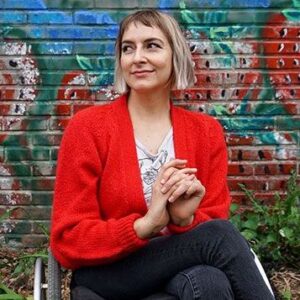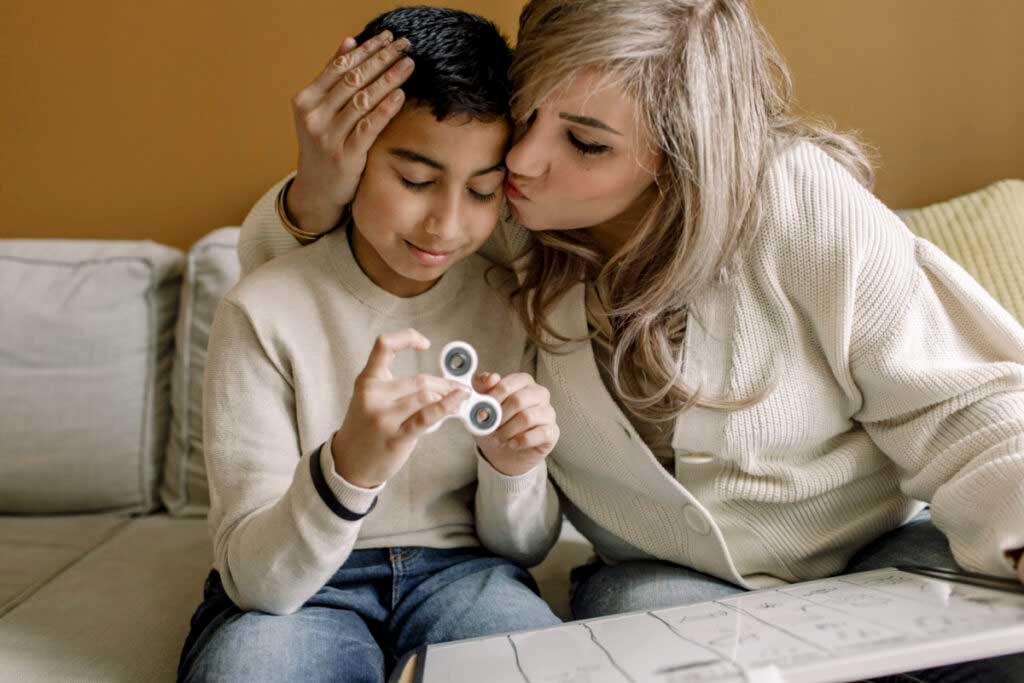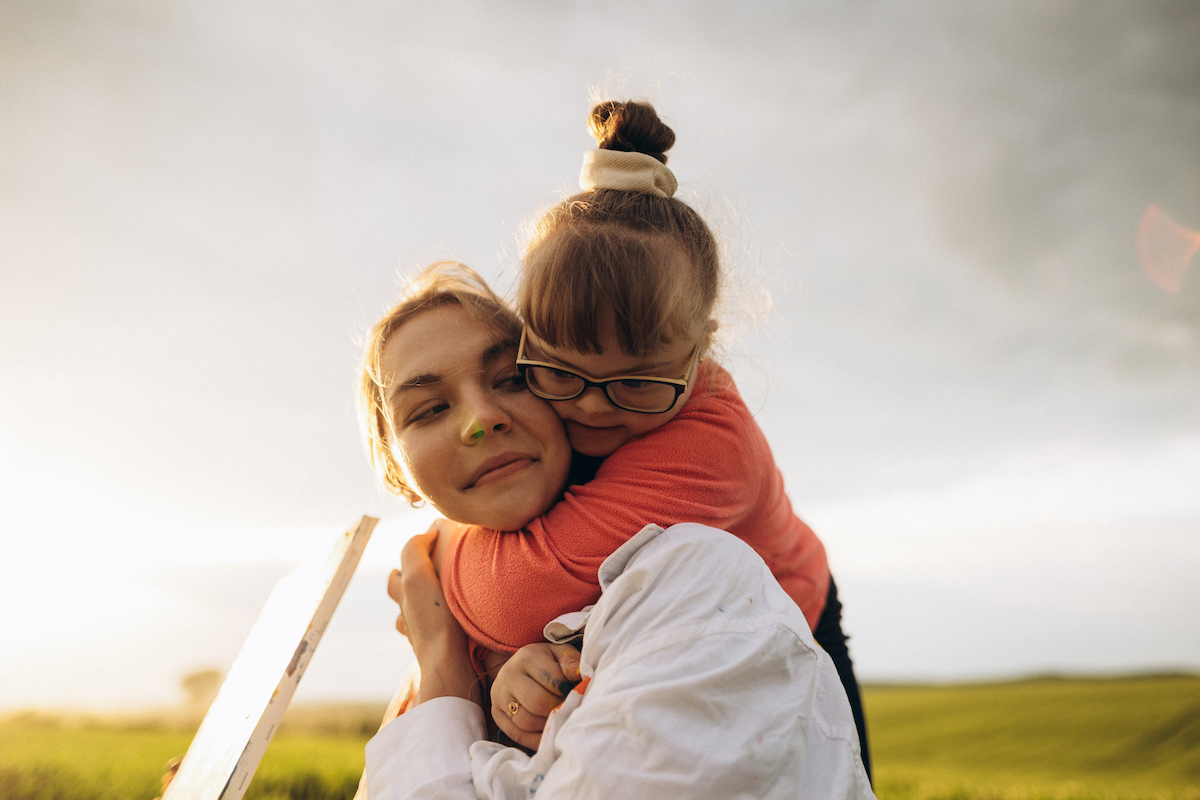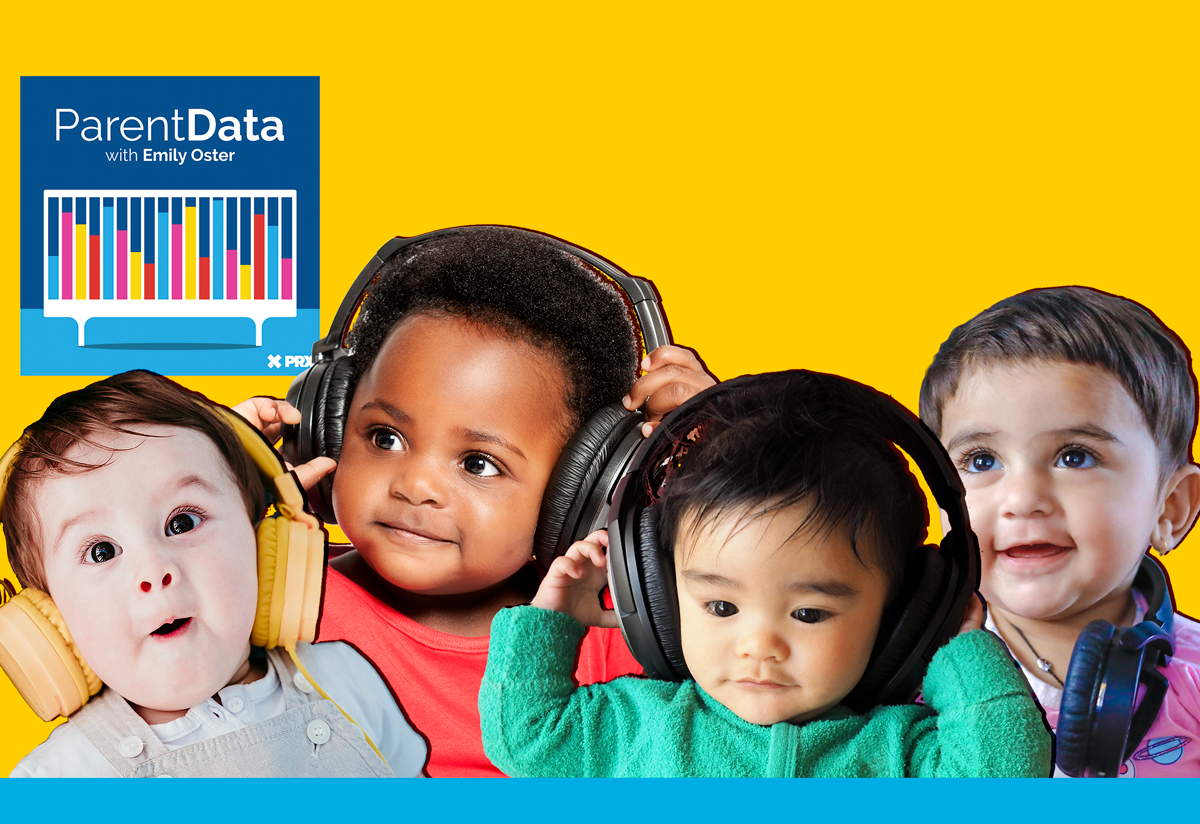I’m so thrilled today to feature an essay from Rebekah Taussig on pregnancy, parenting, and disability. Rebekah is an amazing storyteller who often writes about her family and her identity as a mother in an “ordinary, resilient disabled body.” Today’s essay comes from a full collection called We’ve Got This: Essays by Disabled Parents that includes dozens of parents around the world who identify as Deaf, disabled, or chronically ill. We’re grateful to Rebekah and the editors for letting us share it here. Enjoy this fantastic read as you head into a relaxing post-Thanksgiving weekend. —Emily
The night before our baby was born, I made my partner, Micah, take at least a hundred pictures of my full belly resting atop my paralyzed legs and wheelchair. It was important to bothof us to document this intersection of symbols — parenthood and disability. So often, the two are imagined separately, as if they’re a dichotomy: care receivers versus caregivers, drains on society versus contributors, diseased versus fertile. Everyone sorted tidily into boxes.
I would be lying if I said I’d always been able to imagine myself as a mum. I grew up in a body paralyzed by a series of lifesaving cancer treatments that tore through my tiny frame from the ages of 1 to 3 years old. Even as my body continued to grow into adolescence and young adulthood, there was no denying it was war-torn. I was monitored closely by many doctors, but not one of them seemed interested in talking with me about the possibility of conceiving, carrying, giving birth to, or caring for a baby. “We won’t know until we know,” I heard time and time again. Another way to put it might be, “We’ll cross that bridge when we are forced to.” But what if I was curious about the route we’d take to reach that bridge?
I was 33 when a nurse practitioner finally asked me if I wanted to have a baby. I was there for a routine exam, and she was covering appointments for the doctor I normally saw. I don’t remember exactly how she worded it — “Would you like to get pregnant?” or “Are you and your partner planning to have kids?” — but I remember she asked it warmly and casually, and it surprised me. Is this how the conversation starts for non-disabled women? No medical professional had brought this question up with such unconcerned ease before. How empowering to be invited to consider! Did I want to have a baby?
“I’ve never really known if I could have a baby!” I said in a breathy rush.
“Well,” she said, surprised herself, “let’s find out!”
She connected me with other doctors in the hospital’s high-risk pregnancy clinic, and just like that, we were mapping out a route to the bridge so that we could decide for ourselves whether or not we wanted to cross it.
Despite several doctors giving us the green light to start trying, and although no one had ever given me a concrete reason why I couldn’t or shouldn’t get pregnant, I was shocked when that little test came back with two pink lines: positive! I should have been bursting with joy, but I actually felt full of anxiety and doubt. What did this mean? What was about to happen? Were we going to be okay? Before every appointment for at least the first 25 weeks, I was sure they’d tell me I’d lost the baby.
Each time I went to the bathroom, there was a part of me that expected to see pools of blood. If I didn’t feel the baby kick for a stretch, I prepared myself for grieving. My body’s deficiencies had been drilled so deeply into my mind that I could not fathom it being able to grow and protect a whole baby human. But it did — with very little drama.
As Micah and I thought through the options for our birth plan, my doctor connected me with a pelvic floor therapist. Her job was to perform an assessment so I could make decisions with more concrete information. Despite the widespread assumption that women with paralysis can’t possibly push their babies out into the world, lots of them do. But I wanted to gather as much information as I possibly could before making a choice. Before we met in person, the therapist and I had a chat on the phone. She asked me a handful of questions about my abilities — How long can you stand? How do you pee? Describe how you push when you have a bowel movement. The questions were intimate and sometimes awkward, but I did my best to answer them for this stranger on the phone.
Then, abruptly, she said, “You’re not going to be able to do this.”
Instinctively, I pushed aside the punch of her words and asked, “Why would that be? My doctor hasn’t given me any indication that I can’t give birth vaginally.”
Her answer was simple, and it didn’t seem to have much to do with me at all. “Look, I have worked with patients who are paralyzed and patients who have given birth, and I just can’t imagine that you’d be able to do it.”
“Okay, but have you ever worked with a paralyzed woman who’s given birth?”
“No, but I’ve worked with lots of paralyzed women and lots of women who’ve given birth,” she repeated, as if that should mean something to me, “and I can’t fathom how you’ll be able to do this.”
Her razor-sharp decisiveness took my breath away. The black-and-white authority she wielded on the subject directly contradicted everything my doctor had said, every bit of research I’d done on my own — and yet, in that moment, with her harsh voice ringing in my ears, I found myself feeling silly for assuming I could do this powerful act reserved for non-disabled mothers.
In retrospect, I wish I had pushed back instead of retreating. I wish I had asked if she’d read any literature on women with paralysis giving birth. Whether she knew that women in comas had given birth vaginally. But her voice was insistent and overwhelming; she simply could not imagine the intersection of these identities.
In the end, I did get a C-section. I agonized over the options, but we’d had a year of curveballs in other ways, and ultimately I decided that a scheduled cesarean was the best choice. I would like to think that I came to this conclusion independently, that I was able to extract the ignorance of the pelvic floor therapist from my decision-making process. But I’ll never really know how big a role it played subconsciously.
***
Culturally, we’ve inscribed so much meaning into the images of a pregnant belly and a visibly disabled body. The former is shorthand for life in abundance, while the latter is so often reduced to brokenness. And we seem to have very little experience seeing the two entwined. As this baby grew in my paralyzed body, we busted through the small boxes allotted to us. It wasn’t that I proved my body wasn’t damaged — it very much is — but the brokenness and abundance folded into one another. As I splayed my fingers across my belly and felt our baby’s lively kicks and rolls the night before he was born, I felt awe at our stubborn, sturdy defiance.
***
After Otto was born, I expected us to continue to defy the world’s narrow expectations with as much ease as we did when he lived in my belly, and while I do believe our existence is in itself a sort of audacious subversion, I’m not sure how much of it I could describe as easy.
When he finally arrived, he shocked us with his knowing stares, his intense scowl, his loud and incessant screaming. I was enamored with him and also terrified of him. It was so easy to set him off and so difficult to calm him down. I expected that I would come into the role of his mother naturally and intuitively. And in some ways I guess I did. We figured out nursing like two champions. My boy has never struggled with eating. But I was devastated over and over again by my inability to soothe him the way his standing, bouncing, pacing dad could. I spent months trying to wrangle him into a wrap he could tolerate. There was at least a full week when he wouldn’t even sit in my lap without howling. I wanted to be the living proof that disabled women could be moms too — See? Look at us go! But I felt profoundly incompetent. One night as Micah and I gave Otto a bath, I took a step back, looked at the two of them together, and thought, They might be better off without me here.
***
Slowly, oh so slowly, as the days melded into weeks, Otto and I got to know each other. I learned how to read the signs that he needed a nap, and he learned the textures and rhythms of my wheelchair; he started holding his fingers lightly against the tread on my wheels while I rolled him in soothing circles. And eventually — with time and a bit more sleep — I’ve started to recognize the sound of some familiar notes in this experience of parenting. In this realization, I’ve discovered something jarring: parenting feels an awful lot like being disabled. How counterintuitive! I’d been taught that parenthood and disability were two separate, distinct experiences, and while my pregnancy invited me to play with the imagery, the act of parenting braided into the felt experience of disability in a breathtaking tangle of familiarity. It turns out my disabled body has actually given me the precise training I need to be Otto’s mom. With time, parenting has started to feel more and more like hearing a cover of a song I’ve known by heart since I was a child.
***
My body and my baby are both unpredictable and take turns derailing our plans. They flourish when we lean into flexibility, imagination, and adaptability. They require patience and endurance, attention and care — they thrive when we lean into interdependence. They inspire innovation and new ways of being together; they nurture a tender, sturdy intimacy in our family; they are bewildering, magical, and demanding.
Disability and parenting have brought a host of limitations to the way we make (and break) plans, the venues we can (or, more often than not, can’t) visit, the way it feels to look down a day (especially after a sleepless night). Running on empty, canceling plans for a nap, doing extra research before we venture out — all of this was already part of the deal for me.
Like disability, parenting gives me immediate access to an insiders’ club and fosters fast, deep bonds with people. I remember the morning I was on the phone with the doctor’s office and the person on the other end of the line heard Otto fussing. I expected her to be annoyed, but she asked, “Aww, how old? Is he teething? Oh, I know the feeling!” This brand of solidarity is something I’ve only known with other disabled people — the immediate relief that comes from being with someone who knows, really knows.
As Micah and I continued to make adaptations to our house and car to accommodate Otto’s ever-evolving mobility, we relied on muscles that were already beefy from thinking creatively about how to make a new space accessible to me. We knew how important it was and how much patience it took to find the right tool. We tried so many bassinets, found a creative DIY arrangement for our crib, spent days researching high chairs, bouncy chairs, and exersaucers, and tried at least four different wraps, all with the understanding that it would take time and be totally worth it.
Disability has prepared me perfectly for the inevitable moment at 2 a.m. when I become convinced that my baby will never stop crying — that this single moment is the bubble I will live in for the rest of eternity, that I will never go out for drinks with friends again. I’ve had many moments when my back and legs reached peak pain — when I lost patience with my body for needing my attention — that felt like they’d stretch over the rest of time. But my body has taught me that nothing lasts forever. Even when everything stays the same, the light shifts and the story takes on a different tone. Otto brings me to this moment often, and when the familiar feeling starts to pop its head up, I know to say, “Hello, old friend! I’ve been expecting you.” My disabled body and my growing baby remind me that none of this lasts forever — not the good or the bad, the hard nights or the best mornings.
Maybe more than anything else, disability has prepared me for the both/and experience of parenthood. More than any other experiences I’ve known, they’ve both brought profound depth, pain, joy, loss, connection, frustration, and laughter to my life. They both make my heart ache and fill me with pride. They both bring days that make me want to quit the whole damn thing and days when all the stars align. Feeling loss does not negate gratitude. Feeling frustration doesn’t diminish joy.
How interesting, to sit at the intersection between disability and parenting and feel the similarities wash over me again and again. Because not only are disability and parenting often imagined as two incompatible experiences, but parenthood is generally portrayed as a net gain and disability as an unequivocal loss. Even as both experiences are complicated and all-encompassing, isn’t it interesting to see them pulled apart and pushed into such opposing categories? Can you imagine if the overwhelming response to new parents was heartbreak, condolences, and pity? Or if culturally we were able to recognize potential value in disability? Can you imagine if we responded to parenthood and disability with a resounding, “That could mean anything on earth to you! How do you feel today?” Can you imagine if disabled people were seen as viable, competent parents?
These experiences aren’t a one-to-one comparison, and they aren’t interchangeable. The experience of disability doesn’t mean you automatically understand parenting, or vice versa. Obviously not. But I think we will all benefit if we open our narratives surrounding each. Parenthood can tangle with grief and loss. Disability can include joy and abundance. And goddammit — disabled parents exist. We get to be both. We always get to be both.













Log in